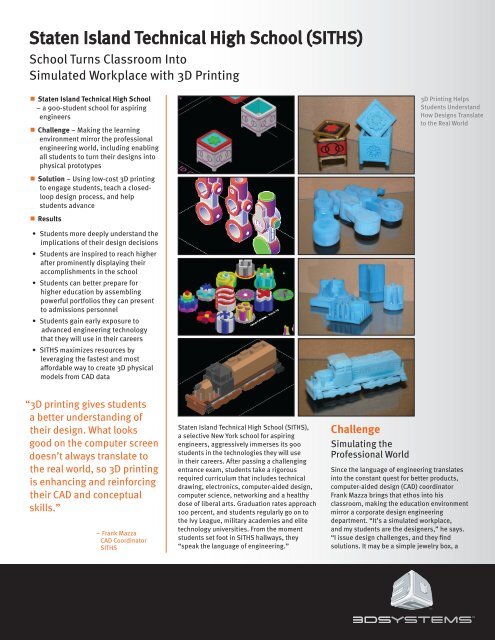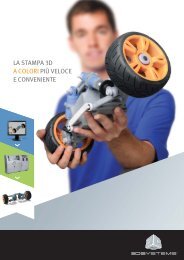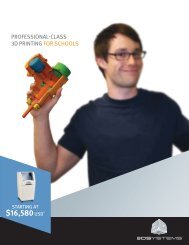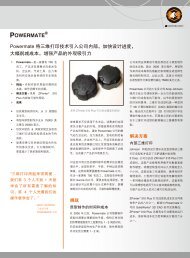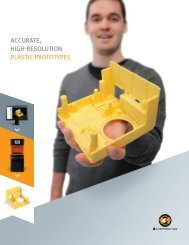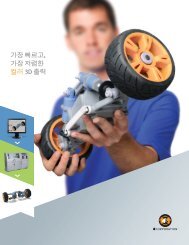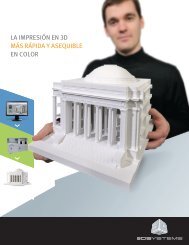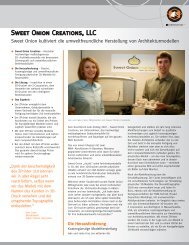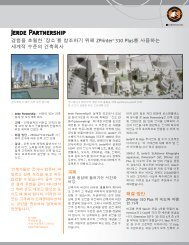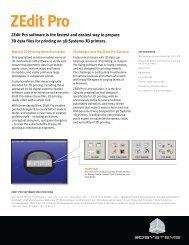Staten Island Technical High School (SITHS) - Z Corporation
Staten Island Technical High School (SITHS) - Z Corporation
Staten Island Technical High School (SITHS) - Z Corporation
You also want an ePaper? Increase the reach of your titles
YUMPU automatically turns print PDFs into web optimized ePapers that Google loves.
<strong>Staten</strong> <strong>Island</strong> <strong>Technical</strong> <strong>High</strong> <strong>School</strong> (<strong>SITHS</strong>)<br />
<strong>School</strong> Turns Classroom Into<br />
Simulated Workplace with 3D Printing<br />
n <strong>Staten</strong> <strong>Island</strong> <strong>Technical</strong> <strong>High</strong> <strong>School</strong><br />
– a 900-student school for aspiring<br />
engineers<br />
n Challenge – Making the learning<br />
environment mirror the professional<br />
engineering world, including enabling<br />
all students to turn their designs into<br />
physical prototypes<br />
3D Printing Helps<br />
Students Understand<br />
How Designs Translate<br />
to the Real World<br />
n Solution – Using low-cost 3D printing<br />
to engage students, teach a closedloop<br />
design process, and help<br />
students advance<br />
n Results<br />
• Students more deeply understand the<br />
implications of their design decisions<br />
• Students are inspired to reach higher<br />
after prominently displaying their<br />
accomplishments in the school<br />
• Students can better prepare for<br />
higher education by assembling<br />
powerful portfolios they can present<br />
to admissions personnel<br />
• Students gain early exposure to<br />
advanced engineering technology<br />
that they will use in their careers<br />
• <strong>SITHS</strong> maximizes resources by<br />
leveraging the fastest and most<br />
affordable way to create 3D physical<br />
models from CAD data<br />
“3D printing gives students<br />
a better understanding of<br />
their design. What looks<br />
good on the computer screen<br />
doesn’t always translate to<br />
the real world, so 3D printing<br />
is enhancing and reinforcing<br />
their CAD and conceptual<br />
skills.”<br />
– Frank Mazza<br />
CAD Coordinator<br />
<strong>SITHS</strong><br />
<strong>Staten</strong> <strong>Island</strong> <strong>Technical</strong> <strong>High</strong> <strong>School</strong> (<strong>SITHS</strong>),<br />
a selective New York school for aspiring<br />
engineers, aggressively immerses its 900<br />
students in the technologies they will use<br />
in their careers. After passing a challenging<br />
entrance exam, students take a rigorous<br />
required curriculum that includes technical<br />
drawing, electronics, computer-aided design,<br />
computer science, networking and a healthy<br />
dose of liberal arts. Graduation rates approach<br />
100 percent, and students regularly go on to<br />
the Ivy League, military academies and elite<br />
technology universities. From the moment<br />
students set foot in <strong>SITHS</strong> hallways, they<br />
“speak the language of engineering.”<br />
Challenge<br />
Simulating the<br />
Professional World<br />
Since the language of engineering translates<br />
into the constant quest for better products,<br />
computer-aided design (CAD) coordinator<br />
Frank Mazza brings that ethos into his<br />
classroom, making the education environment<br />
mirror a corporate design engineering<br />
department. “It’s a simulated workplace,<br />
and my students are the designers,” he says.<br />
“I issue design challenges, and they find<br />
solutions. It may be a simple jewelry box, a
Displaying Innovations in the Trophy Case<br />
is a Point of Pride for <strong>SITHS</strong> Students<br />
“There’s just something very<br />
valuable from an educational<br />
standpoint, to hold an<br />
object in your hands at the<br />
end of the design process –<br />
especially for engineeringoriented<br />
students anchored<br />
in the physical world.”<br />
– Frank Mazza<br />
CAD Coordinator<br />
<strong>SITHS</strong><br />
complex toy, a building, or a machine part with<br />
gears, pistons and threads. We never do the<br />
same thing twice.”<br />
<strong>SITHS</strong>’s challenge is to fill that dynamic learning<br />
environment with the technologies that drive realworld<br />
engineering departments. Like professional<br />
engineers, <strong>SITHS</strong> students start with a concept,<br />
move to a 2D sketch and progress to a 3D CAD<br />
model.<br />
Since design doesn’t end with the 3D CAD model<br />
in professional engineering departments, it<br />
doesn’t end with a 3D CAD model in the <strong>SITHS</strong><br />
classroom. Engineers take ideas beyond 3D CAD<br />
designs to prototypes, enabling them to gather<br />
real-world design feedback and conduct fit and<br />
functional testing. To prepare students for this<br />
environment, <strong>SITHS</strong> needed a way to quickly and<br />
affordably put prototypes into students’ hands.<br />
Solution<br />
3D Printing<br />
<strong>SITHS</strong>, like so many real-world companies,<br />
has discovered a cost-effective way to rapidly<br />
transform designs into physical objects: 3D<br />
printing. A 3D printer is an output device for 3D<br />
CAD data in the same way that a 2D printer is an<br />
output device for the words and pictures on a<br />
computer screen. The primary difference is that<br />
a 3D printer produces three-dimensional models<br />
and prototypes in composite material. 3D<br />
printing is gaining popularity as the equipment<br />
follows the pattern of 2D printers: capabilities<br />
are increasing as prices fall.<br />
The 3D printing breakthrough at <strong>SITHS</strong><br />
occurred in 2005, when Mazza, a professional<br />
engineer, discovered the technology in trade<br />
journals. “I thought, ‘I can use and apply<br />
this in the classroom.’ ” Low operating costs,<br />
high conservation of materials and minimal<br />
post-processing effort were key criteria. After<br />
researching all the standard 3D printing<br />
technologies, the school selected the ZPrinter ®<br />
310 from 3D Systems, maker of the fastest<br />
3D printers with the lowest operating costs.<br />
Results<br />
Portfolios, Pride and Deeper<br />
Understanding<br />
Today, the printer is a busy hub of creative activity.<br />
Mazza hits the print button at the end of the<br />
school day and the next morning removes<br />
finished objects from the printer. The best<br />
ones are placed in a trophy case outside the<br />
classroom, sometimes with the AutoCAD ®<br />
drawings that spawned them. Mazza also uses<br />
the printer to create prototypes that help him<br />
explain design challenges at the outset of an<br />
assignment. Students enhance these designs as<br />
they meet the assigned challenges.<br />
3D printing enriches engineering education in<br />
a number of ways, according to Mazza. First, it<br />
gives students an impressive portfolio they can<br />
present to admissions personnel at colleges and<br />
universities. Second, it familiarizes them with<br />
equipment that’s on industry’s leading edge<br />
and rapidly becoming standard for competitive<br />
companies. “Perhaps most importantly,” he<br />
says, “3D printing gives students a better<br />
understanding of their design. What looks good<br />
on the computer screen doesn’t always translate<br />
to the real world, so 3D printing is enhancing<br />
and reinforcing their CAD and conceptual skills.<br />
There’s just something very valuable from an<br />
educational standpoint, to hold an object in<br />
your hands at the end of the design process –<br />
especially for engineering-oriented students<br />
anchored in the physical world. Showing off their<br />
innovations in the trophy case is a point of pride<br />
for <strong>SITHS</strong> students and keeps them inspired to<br />
continually improve their work.”<br />
<strong>SITHS</strong> students can expect to expand their use<br />
of 3D printing in the future. Science classes,<br />
for example, will use it to print out microscopic<br />
objects like DNA molecules. Electronics students<br />
will use it to better understand electrical<br />
designs. There will be public-private interaction,<br />
such as printing models of buildings for nearby<br />
architectural firms.<br />
“It’s a distinct advantage for our students to<br />
be able to use 3D printing technology that is<br />
important and current in industry,” Mazza says.<br />
“Students leave us smarter and better prepared<br />
to succeed in their careers.”<br />
<strong>Staten</strong> <strong>Island</strong> <strong>Technical</strong> <strong>High</strong> <strong>School</strong><br />
485 Clawson Street,<br />
<strong>Staten</strong> <strong>Island</strong>, NY 10306<br />
USA<br />
www.printin3d.com<br />
333 Three D Systems Circle<br />
Rock Hill, SC 29730 USA<br />
Telephone +1 (803) 326-3948<br />
moreinfo@3dsystems.com<br />
Warranty/Disclaimer: The performance characteristics of these products may vary according to product application, operating conditions,<br />
material combined with, or with end use. 3D Systems makes no warranties of any type, express or implied, including, but not limited to, the<br />
warranties of merchantability or fitness for a particular use.<br />
© 2012 by 3D Systems, Inc. All rights reserved. Specifications subject to change without notice. The 3D Systems logo and stylized text are<br />
trademarks and 3D Systems and ZPrinter are registered trademarks of 3D Systems, Inc.<br />
Issue Date January 2012


